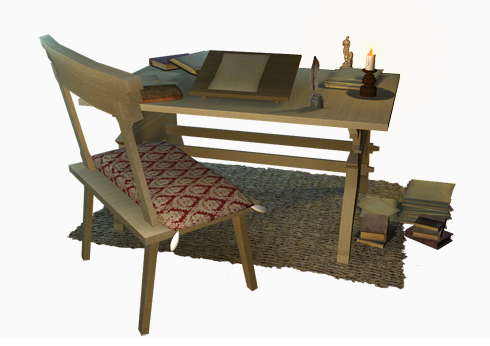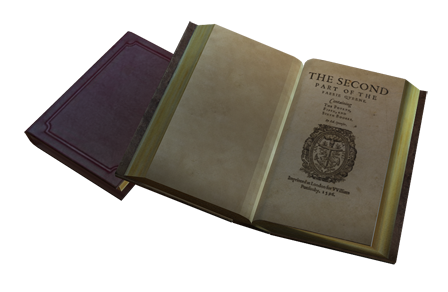Object Descriptions Tower House Study
Desk, with paper, pen and ink, and books (including The Faerie Queene)
This desk, with various papers on and around it, indicates Spenser’s life as a creative writer. In the Ground Floor Parlor of the castle complex is another desk. That area functions as Spenser’s “office” for administrative writing.
Both desks are modeled loosely on that of St Jerome in Albrecht Dürer’s famous print (1514). Spenser would certainly have found inspiration in the early church fathers when writing his own divinely inspired work.
Many writers, such as Michel de Montaigne, Friederich Holderlein and William Butler Yeats, were attracted to towers to work in. Perhaps the physical location on high inspired lofty thoughts, just as it removed one from distractions down below. In the castle recreation here, Spenser’s study is adjacent to his bedroom and above the chapel, both powerful places for the heart and mind.

Almost all surviving examples of Spenser’s handwriting are in the form of letters written while he was secretary to Lord Deputy of Ireland Arthur, Lord Grey or when writing on behalf of other administrators, such as John Norris, President of Munster and his planter neighbor nearby to the south (at Mallow Castle, County Cork). A few rare examples of Spenser’s annotations to poems do exist, however.
On the desk lies Spenser’s magnum opus, The Faerie Queene, open to the title page of the second (1596) edition. As the page declares, it was published in London and “printed for” William Ponsonbie. It shows the emblem (or device) of the printer, Richard Field: the anchora spei or “anchor of hope” that descends from the heavens. Writing epic poetry was both inspired and weighty business, and it took hope for Spenser to make the perilous land-and-sea-journey to London, so as to oversee publication of his work (see the description of such a voyage in Spenser’s poem Colin Clouts Come Home Againe, 1595). It took more hope to return again and to keep writing at Kilcolman, as the political storm-clouds gathered in the north. The name of Spenser’s estate, “Hap-hazard,” indicated its precarious nature.

Literary Connections
In Book II of The Faerie Queene is found the House of Temperance, a castle based allegorically on the human body, wherein the kitchen is the stomach, private rooms are the heart, and so on. The castle’s turret, a “blessed bowre” (FQ II.ix.47.5) functions as the head. It has many rooms, three of which function as the principle parts of the mind and/or higher soul. “Three honorable sages” (47.8) live there, i.e., foresight, judgment and memory. The first of these sages, named “Phantastes,” has “a sharpe foresight, and a working wit/ That never idle was, ne once would rest a whit” and he imagines all sorts of
... idle thoughtes and fantasies,
Deuices, dreames, opinions vnsound,
Shewes, visions, sooth-sayes, and prophesies;
And all that fained is, as leasings, tales, and lies. (FQ II.ix.51.6-9)
The other two men represent the sager and more serious aspects of the mind. The second, judgment (who is unnamed in the poem), has walls
... painted faire with memorable gestes,
Of famous Wisards, and with picturals
Of Magistrates, of courts, of tribunals,
Of commen wealthes, of states, of pollicy,
Of lawes, of iudgementes, and of decretals;
All artes, all science, all Philosophy,
And all that in the world was ay thought wittily. (53.3-9)
The third of these men, “Eumnestes,” represents memory, and
His chamber all was hangd about with rolls,
And old records from auncient times deriud,
Some made in books, some in long parchment scrolls,
That were all worm-eaten, and full of canker holes. (57.6-9)
Combined, the men could represent a well-rounded (and somewhat satirical) portrait of Spenser at Kilcolman: a man of intense poetic imagination and fancy who philosophized, administered and adjudicated on his estate, while also writing antiquarian histories or chronicles (inserted into The Faerie Queene) based on his prodigious reading and memory.
Bibliography:
Raymond Gillespie and Andrew Hadfield (eds), The Oxford History of the Irish Book: Vol. III: the Irish Book in English, 1550-1800 (Oxford: Oxford UP, 2006).
Andrew Hadfield, Edmund Spenser: A Life (Oxford: Oxford UP, 2012): 226-30.
A. Kent Hieatt, “The Projected Continuation of The Faerie Queene: Rome Delivered?” Spenser Studies 8 (1987), 335-42.
David Wilson-Okamura, “When Did Spenser Read Tasso?” Spenser Studies 23 (2008), 277-82.
Links:
http://talus.artsci.wustl.edu/
[accessed 11/30/12]
[texts and digital editing of Spenser’s work, including facsimiles. Directed by Joseph Loewenstein and hosted at Washington University in St. Louis]